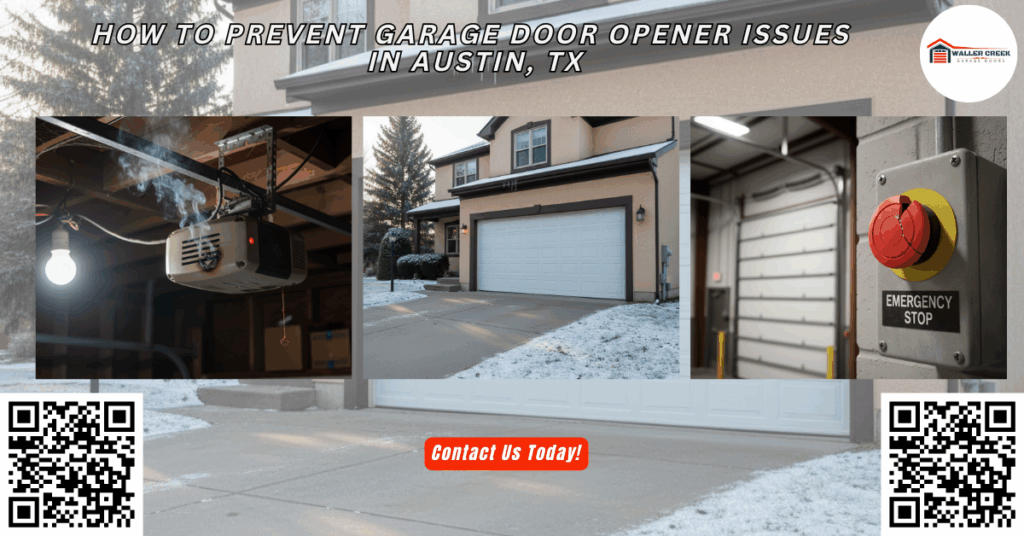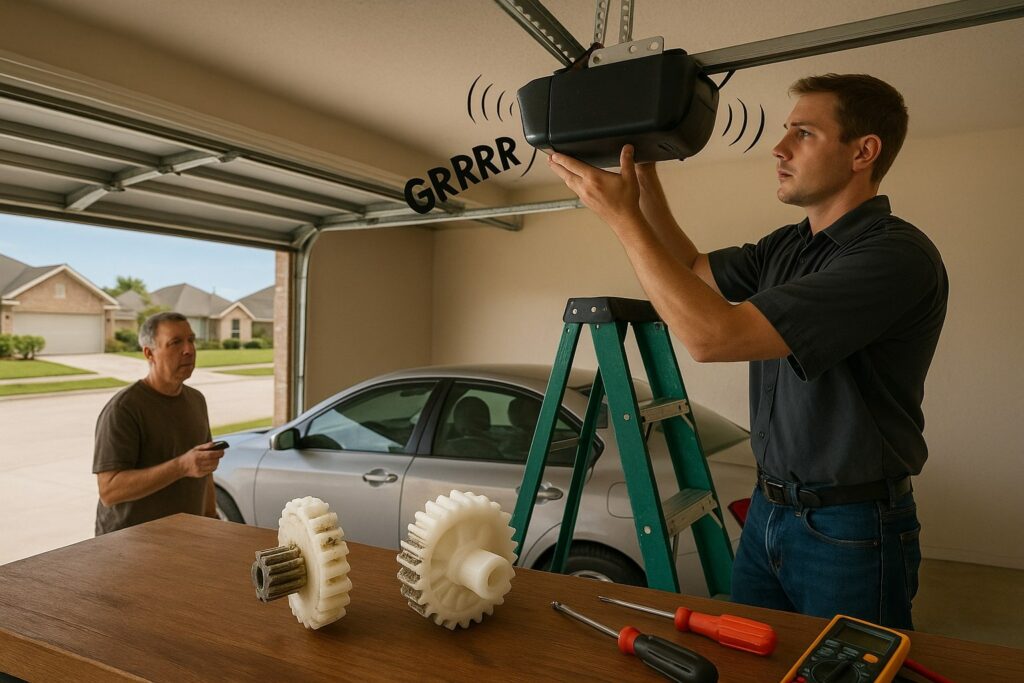
A few weeks ago, a homeowner in the North Loop neighborhood of Austin experienced a stressful morning. Her garage door would not open just as she was leaving for work. After a swift visit from one of our expert technicians, we discovered the problem stemmed from worn-out gears in her opener system that had not been serviced in more than five years. We completed the garage door opener repair during a single visit and restored her peace of mind. However, this issue could have easily been avoided with routine maintenance and early detection.
According to national home service statistics, garage door opener problems account for more than 60% of service calls related to garage doors across residential areas. In cities like Austin, where weather conditions can swing from humid summers to sudden cold snaps, garage door openers are often under continuous strain. They are one of the most used access points in the home, operating multiple times each day to provide convenience and security.
At Waller Creek Garage Doors, we have handled countless garage door opener repair cases. From faulty sensors to worn-out drive belts and fried circuit boards caused by power surges, we understand the most common causes of these issues. The good news is that with proper guidance, regular maintenance, and timely professional help, most garage door opener problems are entirely preventable.
Understanding Why Garage Door Openers Malfunction
Garage door openers are complex systems that involve motors, drive mechanisms such as chain-drive, belt-drive, or screw-drive systems, remote transmitters, safety sensors, and circuit boards. Each of these components must work together in harmony to ensure smooth and reliable operation. When one part of this system fails or degrades, it can impact the overall operation and safety of the garage door.
Some of the most frequent reasons for garage door opener issues include:
- Electrical failures caused by Texas power surges, lightning strikes, or outdated wiring.
- Mechanical wear and tear from consistent daily use over the years.
- Lack of routine garage door maintenance, including lubrication and inspections.
- Environmental effects such as rust due to humidity or component expansion from intense heat.
The type of opener in use also matters. Chain-drive openers tend to create more noise and require regular tension adjustments, whereas belt-drive openers are quieter but more sensitive to environmental damage. Screw-drive and direct-drive openers each have their own unique set of maintenance requirements. Understanding your system type can help you plan appropriate maintenance schedules.
Spotting the Early Warning Signs of Opener Trouble
Detecting early signs of failure can help homeowners avoid costly garage door repairs and replacements. Here are some common indicators that your opener system may be in trouble:
- The garage door is operating more slowly than usual.
- Loud grinding or squeaking noises occur during movement.
- The garage door reverses direction unexpectedly while closing.
- The remote or wall control does not respond consistently.
- Flashing LED lights on the opener unit suggest sensor misalignment or failure.
- The opener motor runs, but the garage door remains stationary.

If you notice any of these signs, it is time to contact a local garage door technician for a full inspection. Delaying repairs can worsen the problem and lead to complete system failure. Regularly monitoring your garage door system for these symptoms is a proactive step toward long-term reliability.
The Impact of Austin’s Weather on Garage Door Openers
Austin, TX, features a diverse climate with long hot summers, occasional freezing temperatures in winter, and periods of high humidity. This weather pattern significantly impacts garage door systems and openers. Extreme heat can overwork electrical components, shortening the lifespan of motors and circuit boards. Humid conditions may lead to rust or corrosion of metal components, and sudden storms often bring electrical surges.
Homes in the Greater Austin Area, including neighborhoods like Travis Heights, Mueller, and South Lamar, should be especially cautious during spring and summer storm seasons. Installing surge protection for your garage door opener and scheduling seasonal maintenance visits can significantly reduce the risk of breakdowns caused by weather exposure. Additionally, considering the use of insulated garage doors with higher R-values can help stabilize internal temperatures and reduce the stress on opener motors.
Preventative Measures for Long-Lasting Opener Performance
Here are practical steps homeowners can take to ensure their garage door opener remains in top condition year-round:
Schedule Annual Professional Inspections
Have a certified garage door technician inspect your system at least once per year. During a professional check-up, the technician will assess the health of the opener motor, inspect the drive system (whether it is chain, belt, screw, or direct drive), and test safety features such as the auto-reverse and photo-eye sensors. Routine maintenance ensures that worn parts are replaced before they fail, and the system operates with precision.
Annual inspections often include a complete system diagnostic, which evaluates electrical performance, structural alignment, and safety compliance. In high-use households, such inspections may be needed semi-annually.
Lubricate Moving Parts Every Six Months
Use a high-quality silicone-based lubricant to maintain smooth operation across all moving components. Key parts to lubricate include:
- Trolley carriage and drive rail
- Rollers and hinges
- Springs and pulleys
Avoid using general-purpose oils like WD-40, which can attract dust and debris. Proper lubrication reduces friction, cuts down on noise, and helps prevent wear. Homeowners in dusty or high-humidity areas may need to perform lubrication tasks more frequently.
Test Safety Features Monthly
Your garage door opener includes built-in safety mechanisms that should be tested regularly. To test the auto-reverse feature, place an object like a paper towel roll or wooden block under the door. When closing, the door should detect the obstruction and reverse immediately. If it fails to do so, the safety sensors or opener logic board may require repair.
Testing the photo-eye sensors by waving a broomstick in front of them during operation can also confirm whether the door is recognizing obstructions correctly.
Install Surge Protection
Power surges are a significant threat to garage door openers. Investing in a surge protector designed for openers can prevent electrical damage during storms or utility outages. This is especially important for homes in Austin neighborhoods prone to frequent lightning activity or older wiring infrastructure.
Professional installation of surge protection devices ensures compatibility with your current model and protects both the opener and your connected smart home systems.
Keep Tracks and Rollers Free of Debris
Dust, leaves, and other debris can collect in the tracks and obstruct smooth operation. A buildup increases resistance during opening and closing cycles, placing unnecessary stress on the opener. Regularly clean the tracks with a soft brush and inspect for alignment issues or rust.
Additionally, using a level to check the horizontal alignment of the tracks can prevent uneven wear and binding problems that strain the opener.
Monitor the Opener’s Sounds
The type and frequency of sounds during operation can reveal a lot about the system’s condition. A well-maintained garage door opener should function with minimal noise. Excessive grinding, rattling, or clunking usually points to worn gears or loose mounting brackets.
Each opener model has a signature sound, and getting familiar with yours can help you recognize when something is off. For example, a sudden shift from a smooth hum to a loud buzz could indicate a motor capacitor issue.
Be Aware of Daily Usage
Most openers are rated for 10,000 to 15,000 cycles. High-traffic homes may reach that threshold much faster. If your garage door is used more than four times a day, consider installing a heavy-duty model, possibly a LiftMaster system equipped with battery backup and advanced safety features.
Installing a cycle counter, available on some modern openers, can help track usage and alert you when maintenance or replacement is due.
What Should Be Done Professionally vs. DIY
While homeowners can handle certain maintenance tasks, such as cleaning photo-eye lenses or lubricating hinges, there are critical elements that require professional expertise. For example:
- Replacing worn drive belts or chains
- Adjusting torsion springs
- Diagnosing and repairing logic board malfunctions
- Programming new remotes or access code technology
Attempting to perform complex repairs without proper training can lead to further damage or even personal injury. Our professional team at Waller Creek Garage Doors is trained to handle all types of garage door opener repairs and installations in a safe, efficient, and cost-effective manner.
How Often Should Maintenance Be Performed?
The following maintenance schedule is recommended for Austin-area homeowners:
- Professional inspection and tune-up once a year
- Visual inspections every three months
- Lubrication of moving parts every six months
- Monthly safety feature testing
Commercial properties, or homes with multiple daily uses, may benefit from quarterly inspections to ensure all opener components remain reliable and secure.
Smart Garage Door Openers and New Technology
Smart garage door openers are increasingly popular across Austin and Central Texas. These models offer smartphone connectivity, scheduling features, remote monitoring, and integration with home automation systems. However, they also introduce new maintenance needs.
To maintain these advanced systems:
- Update the firmware regularly to patch security vulnerabilities.
- Maintain a strong Wi-Fi signal in the garage area.
- Replace the battery backup annually.
- Ensure all connected apps and remotes are updated and synced.

If your system loses its connection or you notice inconsistent response times, a professional diagnostic can help determine if it is a signal issue or a hardware fault. Smart openers with rolling code technology also require updated security settings to prevent unauthorized access.
Real-World Example: A Garage Door That Would Not Close at Night
A homeowner in South Austin recently noticed her garage door would not fully close during the night, which posed a safety risk. Initially, she suspected the power source. However, our technician quickly diagnosed the issue as a misaligned limit switch and a weak battery in the remote control. After recalibrating the system, reinforcing the opener mount, and installing a fresh battery, the issue was resolved in less than an hour.
This real-life scenario underscores how small problems can compromise both functionality and security. With regular attention and prompt service, these situations can be prevented before they turn into emergencies.
When Is It Time to Replace Your Garage Door Opener?
If your garage door opener is over 10 years old, experiences frequent malfunctions, or lacks modern safety features, it might be time to consider a replacement. Indicators include:
- Loud operational noise
- Intermittent door movement
- Delayed response from remotes or keypads
- No battery backup or smart integration
- Inconsistent operation during storms
Upgrading to a modern system with a higher R-value for energy efficiency, better insulation, and advanced safety features ensures both security and long-term savings. Look for options such as LiftMaster belt-drive or screw-drive openers equipped with battery backups and quiet operation. These models are a good choice for homeowners across Austin, North Dallas, and surrounding regions.
Frequently Asked Questions (FAQs)
1. How long does a garage door opener typically last in Austin, TX?
Most garage door openers last between 10 to 15 years with proper maintenance. However, Austin’s heat and humidity can shorten that lifespan if regular inspections and upkeep are neglected.
2. Can I upgrade my old garage door opener to work with smart home technology?
Yes, many older garage door openers can be upgraded with smart conversion kits. These kits allow integration with smartphone apps, voice assistants, and Wi-Fi systems without replacing the entire opener.
3. What type of garage door opener is best for reducing noise in attached garages?
Belt-drive and direct-drive openers are the quietest options, making them ideal for garages attached to living spaces. They operate with minimal vibration and are often paired with insulated garage doors for added sound control.
4. Is it safe to perform garage door opener repairs myself?
Basic tasks like changing remote batteries or cleaning sensors are generally safe. However, electrical repairs, spring adjustments, or motor issues should always be handled by professional technicians to avoid injury or system damage.
Final Thoughts
Preventing garage door opener issues requires a mix of proactive care, attention to small changes, and timely professional inspections. With the right maintenance routine, homeowners in Austin and surrounding areas can avoid costly garage door repairs and enjoy seamless, quiet operation for years to come.
Garage door openers are more than just a convenience. They play a critical role in daily access, home security, and energy efficiency. Whether you live in North Austin, Round Rock, Pflugerville, or the Triangle, staying informed and engaged with your garage system is one of the best investments you can make for your home.
Investing in regular service, upgrading outdated systems, and relying on trusted local technicians ensures that your garage doors, openers, and safety features continue to perform at their best.
How Can Waller Creek Garage Doors Help You?
At Waller Creek Garage Doors, we offer precision garage door opener repair, maintenance, and installation across Austin, TX, and surrounding neighborhoods. Our dedicated team of trained technicians is equipped to handle all garage door systems, including smart openers, screw-drive models, chain-drive openers, and more.
Here is how we serve our community:
- Fast same-day service appointments
- Expert diagnosis and repairs
- Safety sensor testing and calibration
- Surge protection installation
- Replacement parts and new garage doors
- LiftMaster garage door openers with battery backup and advanced security features
Whether you need garage door repair, opener maintenance, or a full system replacement, we are your trusted partner in the Austin area.
Address: 816 Tirado St, Austin, TX 78752 USA
Phone: (512) 642-5669
Contact us today for a free estimate or to schedule your next maintenance check. Let Waller Creek Garage Doors bring you peace of mind with reliable service and top-tier craftsmanship.
- How to Prevent Garage Door Opener Issues in Austin, TX
- How to Prevent Garage Door Problems with a Tune-Up in Austin, TX
- Garage Door Maintenance in Austin, TX: Affordable Services to Protect Your Doors
- Garage Door Types Transforming the Look of Austin, TX Neighborhoods in 2025
- What Austin, TX Businesses Gain From Scheduling Commercial Garage Door Repair Services
